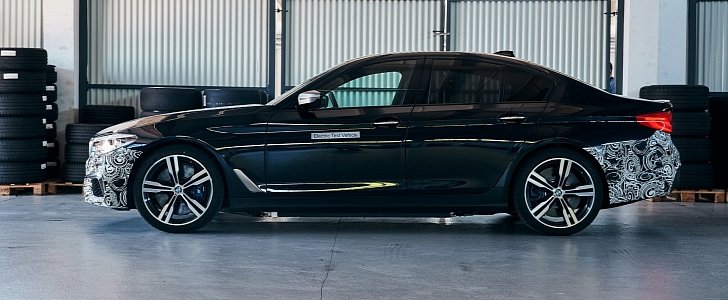As opposed to the M5, the 5 Series is also available with 2.0- and 3.0-liter turbo diesels. Codenamed G30 for the sedan, the mid-size executive car is even more efficient if you’re willing to spend your hard-earned cash on the 530e iPerformance plug-in hybrid.
But BMW has bigger plans for the 5 Series. Enter the Power BEV, a one-off that looks like a 5 Series but happens to be an all-electric sedan. Equipped with the Bavarian automaker’s fifth-generation electric drive unit, the Power BEV outputs “in excess of 720 PS” (710 horsepower) and “around 10,000 Newton meters” from a three-motor setup.
Let that sink in for a minute, then try to imagine how long would it take for the experimental EV to hit 100 km/h (62 mph) from a standstill. “Comfortably under three seconds” is how BMW puts it, making the Power BEV quicker than the M5 Competition super sports sedan.
Baptized Lucy for some reason or another, the one-of-a-kind concept features two motors at the rear and one at the front. A 45-kWh battery will have to suffice because BMW didn’t want to hamper down on the dynamic abilities of the Power BEV with additional weight. Those two electric motors driving the rear axle are controlled separately, thus enabling e-torque vectoring.
The Bavarians claim this setup “is more effective and precise than a limited-slip differential,” although what did you expect? Electric drive and internal combustion are different in nature, and there’s no denying the EV has the upper hand in many aspects. Lest we forget, the Tesla Model 3 Performance accelerates quicker off the line than the BMW M3, Mercedes-AMG C 63 S, and Alfa Romeo Giulia Quadrifoglio.
Back to the Power BEV, the electric motors are “entirely free of rare earths.” This helps bring down production costs, and yes, “an electric motor of this type will make its series production debut in the iX3.”
Now that the iX3 has been mentioned, it should be highlighted that both the electrified X3 and 5 Series share the CLuster ARchitecture. In other words, BMW could re-engineer the 5 Series with the e-powertrain of the iX3 if the higher-ups could make a case for such a model.
Let that sink in for a minute, then try to imagine how long would it take for the experimental EV to hit 100 km/h (62 mph) from a standstill. “Comfortably under three seconds” is how BMW puts it, making the Power BEV quicker than the M5 Competition super sports sedan.
Baptized Lucy for some reason or another, the one-of-a-kind concept features two motors at the rear and one at the front. A 45-kWh battery will have to suffice because BMW didn’t want to hamper down on the dynamic abilities of the Power BEV with additional weight. Those two electric motors driving the rear axle are controlled separately, thus enabling e-torque vectoring.
The Bavarians claim this setup “is more effective and precise than a limited-slip differential,” although what did you expect? Electric drive and internal combustion are different in nature, and there’s no denying the EV has the upper hand in many aspects. Lest we forget, the Tesla Model 3 Performance accelerates quicker off the line than the BMW M3, Mercedes-AMG C 63 S, and Alfa Romeo Giulia Quadrifoglio.
Back to the Power BEV, the electric motors are “entirely free of rare earths.” This helps bring down production costs, and yes, “an electric motor of this type will make its series production debut in the iX3.”
Now that the iX3 has been mentioned, it should be highlighted that both the electrified X3 and 5 Series share the CLuster ARchitecture. In other words, BMW could re-engineer the 5 Series with the e-powertrain of the iX3 if the higher-ups could make a case for such a model.



















